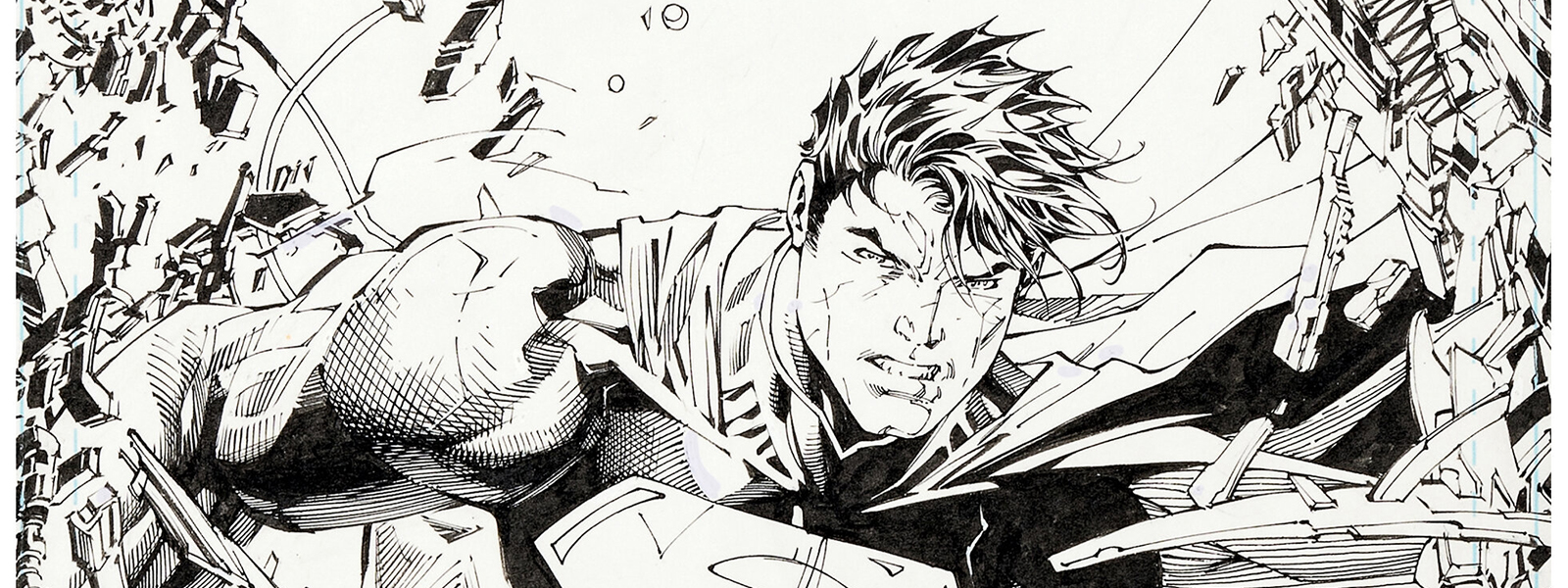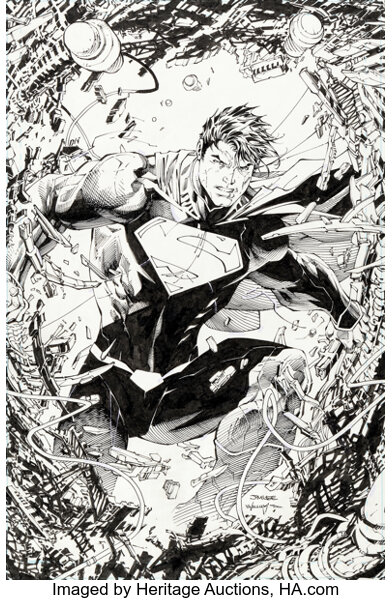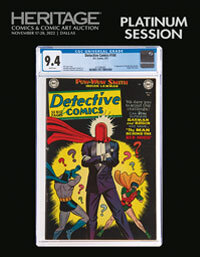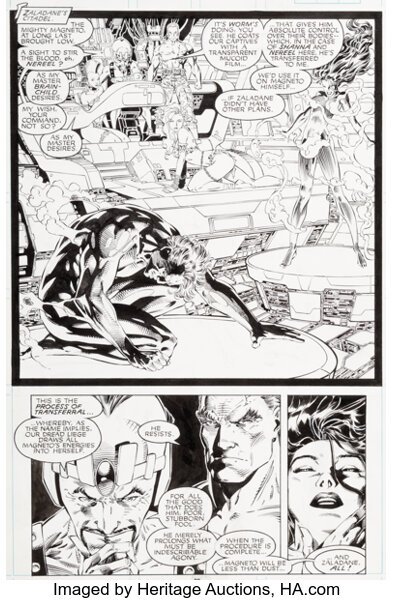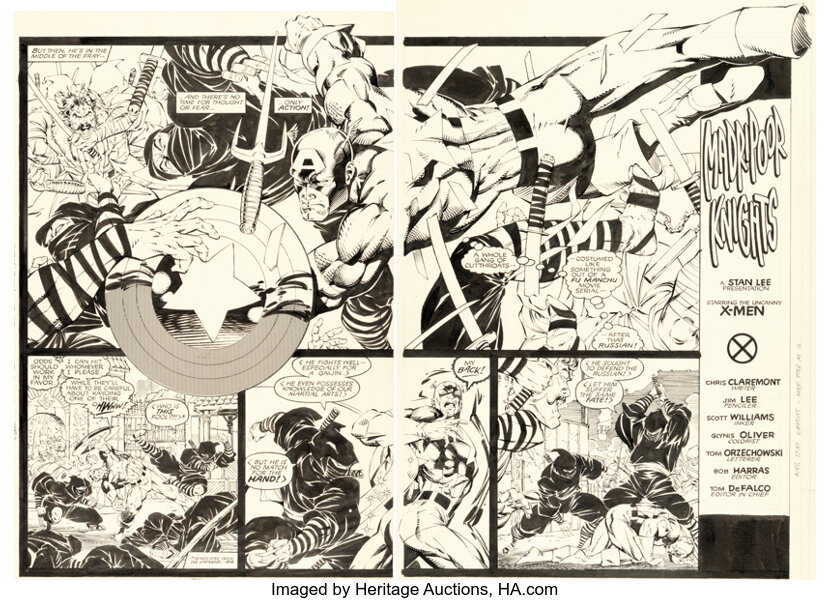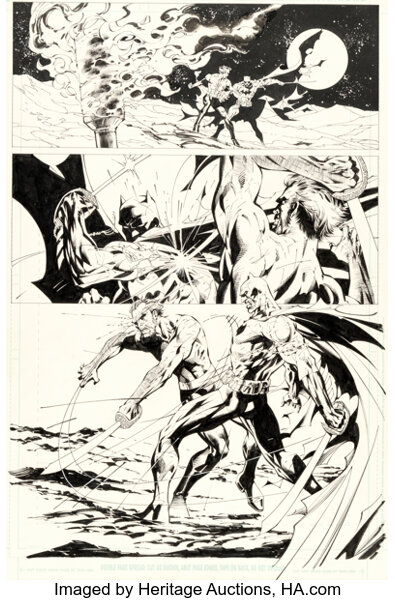THE CREATOR OFFERS WORKS FROM HIS HISTORIC RUNS ON ‘THE PUNISHER WAR JOURNAL,’ X-MEN TITLES, ‘DEATHBLOW,’ ‘BATMAN’ AND ‘SUPERMAN UNCHAINED’
By Robert Wilonsky
It’s a question often asked by the outside observer perplexed by the ever-increasing interest in and value of original pages of comic-book art: Why? Yet the answer remains straightforward; the explanation is perhaps even obvious. Because these are the raw, handmade images that sparked the imagination of countless children raised by superheroes and their archnemeses. They are the singular moments before these graphite-on-Bristol board renderings were replicated for spinner racks and comic-shop shelves. In a world where everything can be read at any time, these are the comic industry’s true one-of-ones.
“There’s this strange feeling when I see something I’ve thumbed past a hundred or a thousand times,” says Jim Lee, “and it’s this reminder that an individual sat down and created this image that was mass-produced and shared around the world.”
Of course, Lee is such an individual: He has been making comic books since 1987, when the Princeton University graduate with a psychology degree – true story – was hired to pencil Marvel Comics’ book about Canadian superheroes. In time, Lee worked on The Punisher War Journal and The Uncanny X-Men; created the best-selling title of all time (1991’s X-Men); co-founded a publishing company (Image Comics) and launched an imprint (WildStorm). Eventually, he jumped ship to DC Comics, where he worked on some of the company’s most compelling and thoughtful modern-day story arcs (Batman’s “Hush” and Superman’s “For Tomorrow”) en route to becoming its publisher and chief creative officer.
Nov. 17-20, 2022
Online: HA.com/7283a
INQUIRIES
Lon Allen
214.409.1261
LonA@HA.com
“It always trips me out that here’s the original art and that someone drew this,” Lee says. “It resets the clock for me every time. What we love as a hobby was all generated by human beings who have a passion for their craft and brought these images to life that didn’t exist before. It’s very magical.”
He laughs.
“You’d think after all these years I’ve been in the business I’d get a little jaded to this, but, thankfully, I am not. It’s a great reminder that this art form is beautiful and magical and that the power of nostalgia is very strong. That explains the transformation of something created in service of a story into singular pieces of art to be cherished and treasured and framed and put in museums. It’s mind-boggling how beautiful this stuff is – and how powerful it is even after all these years.”
Lee has long been among the industry’s most revered and imitated creators; as Comics Alliance succinctly noted in 2016, “His hyper-detailed, fine-line technique has inspired legions of imitators and influenced generations of creators, making him one of comics’ best-known and most recognizable personalities.”
Yet Lee, too, counts himself among the privileged collectors of original art for the myriad reasons enumerated above. And for those very reasons, he now offers his work through Heritage Auctions, where collectors have, in recent years, paid record prices for some of his most prized and iconic pieces. Last June, Lee and inker Scott Williams’ cover for Batman No. 619 – Part 12 in the “Hush” storyline, a triple-gatefold featuring the Batman Family – sold for $504,000.
The November 17-20 Comics & Comic Art Signature® Auction will feature several more Lee originals, an assortment that spans nearly the entirety of his career – from The Punisher War Journal and both X-Men titles through Image’s Deathblow to his work at DC on “Hush” and Superman Unchained, for which Lee offers the potent and oft-reproduced cover for the Issue No. 1.
“As I’ve gotten older and started collecting other things, I realized I was heavily weighed down by my own art, so I am happy to bring it out of the vault and share it with the world,” Lee says. “People are getting the chance to bid on some of the art I held on to for my own collection. I am trying to pick interesting pieces from particular moments over the years. I discovered that there are different segments of fans who like particular runs or stylistic periods. My work has evolved, and some fans like the early work or Image or DC or the X-Men. So there’s a little bit of something for everyone as I curate the offerings.”
Below, Lee offers insight into some of the works available in November.
Page 4 from 1988’s The Punisher War Journal No. 1 by Carl Potts and Jim Lee
For those early pages of Punisher, I was penciling and inking myself for the first time, which was challenging and stressful. On every page I was pushing myself and learning new techniques.
Pages 2-3 from 1990’s The Uncanny X-Men No. 268
This issue has to be one of my Top 3 favorite single issues, so this is something I did pause about including; I had second and third thoughts. I just remember drawing those first three pages with Captain America and the ninjas, trying to capture the dynamism of the character. At the time, I hadn’t drawn a lot of Cap; it was one of my first professional takes of drawing that character and then The Hand ninjas from Frank Miller’s run on Daredevil. There’s a lot of weight on your shoulders. But I had tremendous fun drawing the World War II Captain America in The Uncanny X-Men.
There are so many firsts and interesting aspects to this piece. He’s just a dynamic character, and having him face off against The Hand was an unlikely pairing. Then bringing in Wolverine before he was known as Wolverine was a bit of world-building no one expected.
Page 23 from 1991’s The Uncanny X-Men No. 275 with Scott Williams
Page 1 from 1991’s The Uncanny X-Men No. 277 with Scott Williams
Pages 18-19 from 1992’s X-Men No. 5 with Art Thibert
The X-Men was a childhood dream, getting to bring my favorite characters to life and guide their destinies and fates in the comics. When you first start in this business, you’re so close to your fan experience you’re pinching yourself. You get to draw these characters for real. You’re part of the history that is being shared around the world. It’s all driven by passion and your love of the comics and the characters you collected.
By the time I got to DC and could reflect on the world and the impact on fans, you have a different perspective. You do realize you’re creating nostalgia for future generations. In the beginning, I was just so thankful I could indulge and create and continue the stories I had in my head as a fan. The longer it goes on, you realize these stories can inspire people to seek careers in the graphic arts to become things they felt they couldn’t ever become. There was another layer of responsibility that came with that. But you don’t want it to hold you back from having fun and bringing your full creativity to it.
Page 2 from 1993’s Deathblow No. 2
Pages 10-11 from 1996’s Deathblow No. 0
I was a huge fan of Frank Miller, and when he did Sin City he completely reinvented himself, and it was so powerful and inspirational. I couldn’t help but sit down and try to draw something influenced by that dark, heavy black-and-white effect. It was so much fun playing in that sandbox. I knew it wouldn’t be my de facto style, but as a one-off project, man, that was fun. When Sin City came out, it brought out the inner kid in me. It made your jaw drop. It’s powerful and moving, which is the definition of great art. Finding a piece of art that was life-changing when I first encountered it as a fan has been the impetus behind buying and collecting original art.
Page 16 from 2003’s Batman No. 616 “Hush: Chapter 9” with Scott Williams
Page 4 from 2003’s Batman No. 617 “Hush: Chapter 10” with Scott Williams
By the time I got to “Hush,” I felt more comfortable with my style and how I told stories. It was a focus on technique, storytelling and the introduction of watercolor. I also enjoyed playing in this DC sandbox with Batman and his rogue’s gallery. I had more confidence, more experience. All these things inform the artwork I created.
Jim Aparo was also one of my favorite Batman artists. I grew up reading DC in the 1970s and ’80s. He was my Batman artist. Neal Adams influenced him, but I had more stories drawn by Jim Aparo. Jim, Neal, Marshall Rogers, Frank Miller, David Mazzucchelli – those are the five artists who impacted the way I draw Batman.
When I started drawing Ra’s al Ghul, I talked to Scott Williams, who was a huge Neal collector and Batman aficionado, and we talked about what made Ra’s unique. At the beginning of the immutable and definitive things, he said the first time Ra’s showed up, he was creepy-looking because he didn’t have eyebrows. I heard that and tried to incorporate that, but eventually I thought it looked too weird.
 ROBERT WILONSKY is a staff writer at Intelligent Collector.
ROBERT WILONSKY is a staff writer at Intelligent Collector.

